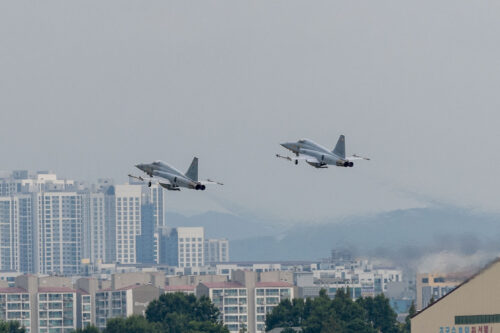Two Chinese teenagers have been detained by South Korean authorities for illegally photographing military aircraft at an air force base in Suwon, according to a report published by JoongAng Ilbo on Apr. 7.

The Gyeonggi Southern Provincial Police Agency’s security investigation department has formally charged the two Chinese nationals, both in their late teens, with violating the Military Installations Protection Act after they were caught photographing fighter jets at the Republic of Korea Air Force 10th Fighter Wing in Suwon.
According to JoongAng Ilbo, the incident occurred around 3:30 PM on Mar. 21, when the suspects used DSLR cameras and mobile phones to capture images of fighter jets during takeoff and landing operations at the military facility. A local resident witnessed the suspicious activity and promptly contacted police by dialing 112, South Korea’s emergency number.
Security investigators from the Hwaseong Dongtan Police Station and counter-terrorism officials responded to the scene and apprehended the individuals. During subsequent questioning, authorities discovered numerous photographs of military aircraft stored on the suspects’ devices.
Police investigation revealed that the Chinese nationals are high school students who had entered South Korea on tourist visas just three days before the incident. While one of the suspects claimed during interrogation that “photography of aircraft is just a hobby,” investigators remain skeptical of this explanation.
“We cannot disclose detailed information as the investigation is ongoing,” a police official told JoongAng Ilbo. “We have imposed a travel ban and are continuing to track their activities.” Authorities are conducting forensic analysis of the suspects’ electronic devices to determine if they photographed other military installations or national security facilities during their stay in South Korea.
Growing Pattern of Security Concerns
The Suwon incident is the latest in a series of concerning cases involving Chinese nationals photographing sensitive locations in South Korea. Security experts are increasingly worried about what appears to be systematic surveillance of military and strategic installations.
In December 2024, JoongAng Ilbo reported a particularly serious case where three Chinese students were caught using drones to photograph the USS Theodore Roosevelt, a U.S. nuclear-powered aircraft carrier, docked at Busan Naval Operations Command. The incident occurred on Jun. 25, 2024, coinciding with President Yoon Suk Yeol’s visit to the vessel.
According to a joint investigation by police, the Defense Security Support Command, and the National Intelligence Service, one of the Chinese students had been recognized as an “outstanding Communist Party member” at a Chinese university in May 2021. Forensic analysis of the students’ phones reportedly revealed contacts with Chinese security officials and numerous Communist Party newsletters.
Investigators believe these students may have been conducting long-term surveillance of South Korean and U.S. military facilities, having found hundreds of photographs of military installations on their devices. Evidence suggested they had conducted reconnaissance of the area surrounding the Busan Naval Operations Command in September 2022 and had previously photographed the USS Springfield, a U.S. nuclear submarine, and the USS Nimitz aircraft carrier when they docked in Busan in February and March 2023.
The students were caught when an Army soldier on security detail for President Yoon’s visit reported a drone flying near the event site, leading to a joint military-police operation that detained the three individuals.
In November 2024, a Chinese tourist in his 40s was arrested for flying a drone that captured images of the National Intelligence Service headquarters in Naegok-dong, Seoul. According to JoongAng Ilbo, the man was flying a drone to photograph Heonin Royal Tombs (Historic Site No. 194) when he also captured footage of the nearby NIS building.
In January 2025, another Chinese tourist was arrested for using a drone to photograph Jeju International Airport, a top-level national security facility. JoongAng Ilbo reported on Jan. 10 that the tourist flew an unauthorized drone approximately 2km outside the airport runway on Dec. 31, 2024.
Legal and Security Implications
The police have stated that they are keeping all possibilities open in their investigation of the Suwon Air Base incident, including potential espionage connections, given this pattern of Chinese nationals photographing sensitive South Korean installations.
The series of incidents has prompted discussions about strengthening legal frameworks to address foreign espionage. As reported by JoongAng Ilbo, the current South Korean espionage laws primarily target activities benefiting North Korea, making it difficult to prosecute espionage conducted for other countries.
In response to these concerns, the Legislation and Judiciary Committee of the National Assembly approved an amendment to Article 98 of the Criminal Code in November 2024, expanding the definition of espionage targets from just “enemy states” to include “foreign countries or equivalent organizations.”
For more information, hit the Source below